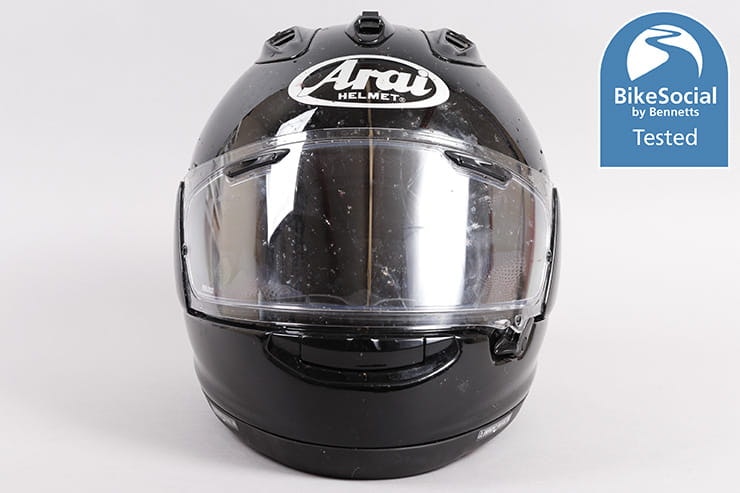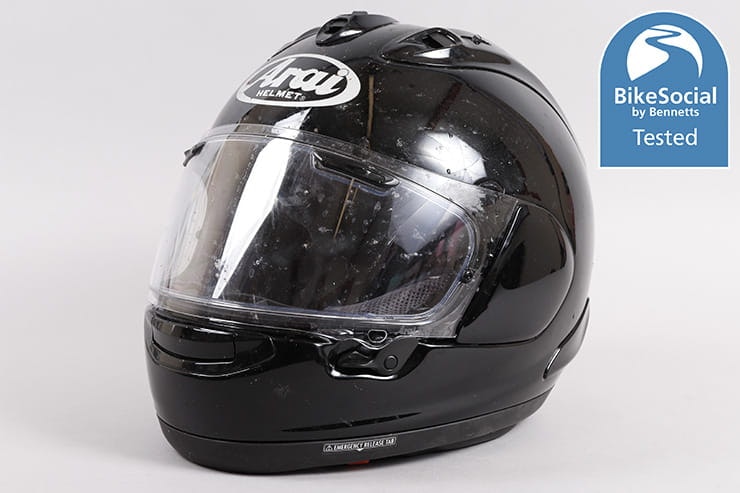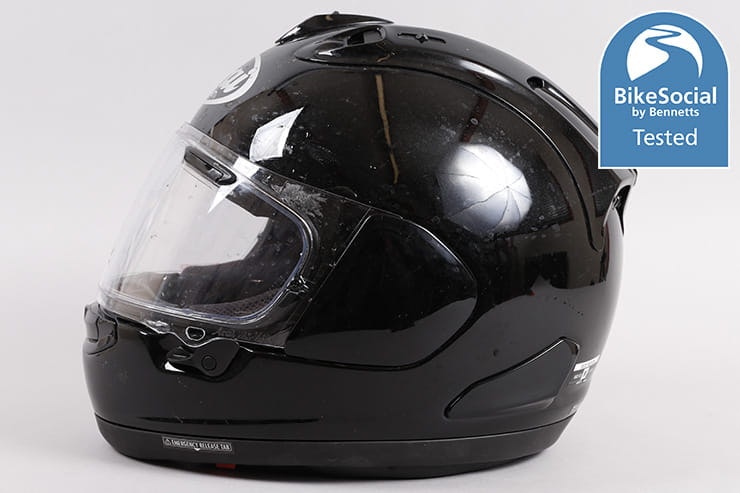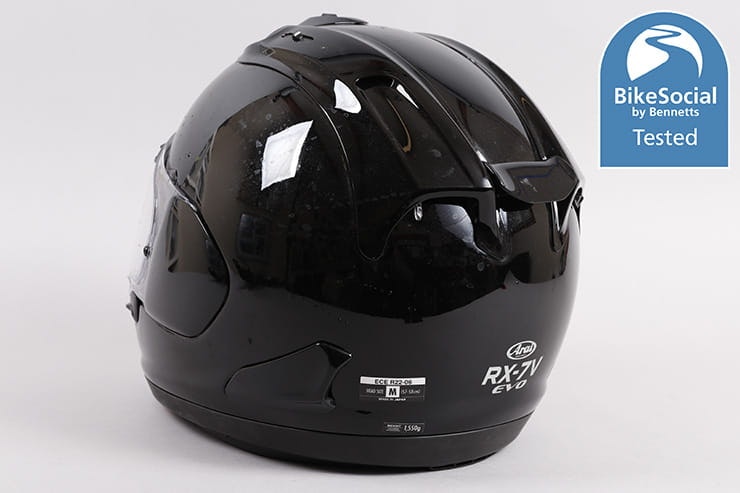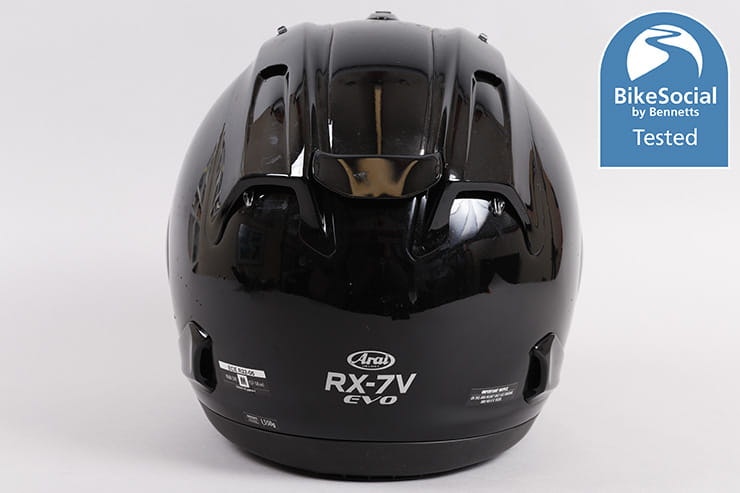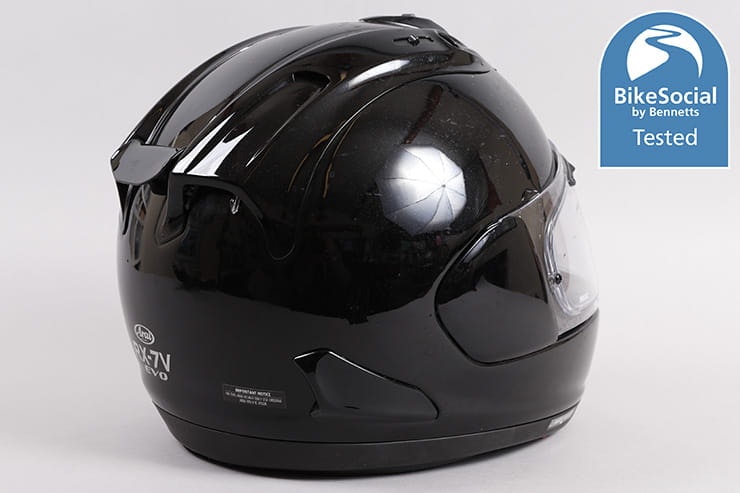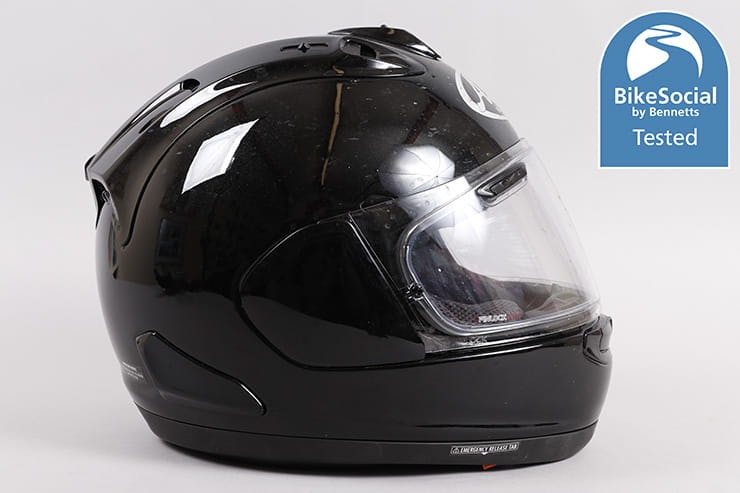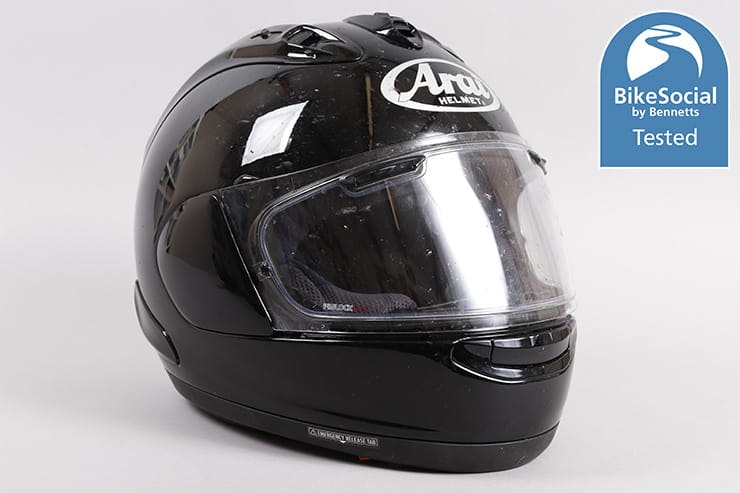Arai RX-7V Evo review | ECE 22.06 motorcycle helmet tested
By John Milbank
Consumer Editor of Bennetts BikeSocial
25.01.2023
Date reviewed: January 2023 | Tested by: John Milbank | RRP: From £699.99 | www.whyarai.co.uk
The Arai RX-7V has long been the flagship motorcycle helmet from the Japanese brand. Doggedly sticking to its rounded design shape, which the company has always claimed makes for higher performance in ‘glancing-off’ impacts, the new RX-7V Evo is basically the same as the previous model, despite being tested and certified to the new, potentially much safer ECE 22.06 standard.
I’ve been wearing it for several months on a BMW R1250GS, Honda VFR800 and a Kawasaki ZX-6R to find out if it’s any good…
Excellent stability and fit
Outstanding ventilation
ECE 22.06 certification
Visor lock awkward with the right hand
Bugs can bullseye their way into the top vents
While Arai uses a lot of the same techniques in its other helmets, the RX-7V Evo is the top-end of its complex, very strong shell design
Outer shell
This RX-7V Evo uses Arai’s PB-SNC2 shell; Peripherally Belted Structural Net Composite. Using a mix of fibres and resin, along with a mesh belt running across the top of the visor aperture and a large net structure inside the main ‘bowl’, the completed shell is very, very strong. Arai’s philosophy is to have a tough outer with a softer inner shell, which can be part of the reason the lid seems to mould to your head-shape more readily; a thinner, more flexible outer as sometimes seen in cheaper polycarbonate lids, for instance, will require a firmer inner EPS (expanded polystyrene), which some might find less comfortable.
I’ve got the gloss black version on test, which has a subtle metallic flake to it and retails at £699.99. You can also get it in plain gloss white or matt black. Graphics add another £100 to the price, except the IOM TT limited-edition, which is £875.00. The RX-7V Evo range is certainly not cheap, but nor does it look it, with excellent finishing across the entire helmet.
I’ve found that some Arais can suffer small surface paint chips a little more readily than others at times, though I’m pleased to say that I haven’t seen any stone damage on this lid as yet.
Weight
Some people will claim that Arais are heavy, and hold one in one hand while you have some other brand in the other and they can feel significantly different. But while that might be a great way to sway a buyer for whatever reason, I can honestly say that I’ve never thought of any helmet as being too heavy when I’m wearing it.
What matters is how the helmet performs in the wind, and the RX-7V EVO cuts through the air without any problems, also not showing any signs of drag when turned to the side.
This medium weighs a measured 1,568g, which is just 18g more than the claimed weight. It’s 20g lighter than the Arai Quantic, but I really think you’ll struggle to know in use.
While we haven’t had a chance to review one, the new ECE 22.06-approved Shoei X-Spirit Pro is probably the closest rival to the RX-7V Evo, and it has a claimed weight of 1,450g. Interestingly, the ECE 22.05-approved Shoei X-Spirit III weighs a claimed 1,350g.
Vent performance is excellent, with some very clever touches like the brow vents and the visor aperture exhaust ports.
Ventilation
The RX-7 range has long been known for its high-performing ventilation. Here’s what this model’s got:
1x two position and closed chin vent feeding the mouth or across the inside of the visor
2x internal visor exhaust ports, dragging air from the inside of the aperture, out through 2x side exhaust ports
2x two position and closed brow vents in the visor, feeding the forehead
3x two position and closed top intake vents
2x two position and closed top exhaust vents
2x two position and closed rear exhaust vents
1x exhaust vent in rear of neck skirt
With all the vents closed the Arai is very still and comfortable, though not stuffy, which is probably helped by those two visor aperture vents, which, along with the neck skirt vent, are the only ones always open.
I tend to ride with the top vents only half open, but the performance is still excellent, passing loads of air into the lid, across your head and out of the back. Opening them up fully only has the disadvantage that the top ports are big enough to let a horsefly or wasp in. That might seem less likely to happen than getting a photon torpedo down a space station’s exhaust port, but I have had it happen to me once, and while I didn’t get stung, feeling it in there is pretty horrible as you frantically pull over and rush to get the lid off.
I’d like to see optional coarse foam inserts for the three top vents (like that fitted in the mouth vent), or a fine mesh across the opening, but Arai tells me that it’s designed to let the absolute maximum air flow in possible.
The four exhaust ports that are underneath the ducting on the top are operated by two levers that you can reach with gloves on, assuming you haven’t fitted the rear diffuser.
The diffuser adds to the aerodynamics of the helmet, but fitting it means you can’t adjust the exhaust control levers without using a pencil or similar to reach up inside. It’s included (but not fitted) with all UK officially-sold RX-7V Evos, but as I ride on the road and didn’t notice any real difference, I’ve taken mine back off as it can also make the lid a bit awkward to fit in some luggage.
The top vents are very easy to operate with gloves on, as is the chin vent. The brow vents are more awkward to set half open, but swiping them fully open or closed isn’t a problem while riding.
Overall, the RX-7V Evo really is a benchmark in ventilation performance, and certainly on track it’s a superb piece of kit. On the road in particularly hot climates it also has very real benefits, but while the RX-7 range has long been Arai’s top seller, even to touring riders, the new Quantic also offers superb venting, if not quite as powerful (or with the same potential to allow big bugs in).
Fitted between the two rear exhaust vents is a small spoiler, which can be adjusted to control airflow over the helmet. I’m sure Jonathan Rea and Michael Dunlop can tell the difference in tweaking it up and down, but I can’t. It looks cool though.
The visor has a smooth, ratchetless system, but the lock can have its quirks.
Visor
The Arai visor system has long been a bone of contention for many riders. Maybe it’s because the first helmet I bought back in 1996 (under the advice of a mate) was an Arai, but I’ve never had a problem with it. I could even remove the visor and fit a new one while it was on my head.
Over the years, the mechanism has been tweaked, and now there’s none of the pulling apart and feeling like something might break. Open the visor, press the button on each of the side pods, then rotate the visor down again until the brass pin pops into the red recess; the visor then just lifts off. Putting it back on simply involves locating those pins again and holding them down while you rotate the visor up. Then clip the side pods back on and you’re done.
I get why some people don’t like it as it’s not immediately obvious, but the instructions are clear enough. If you’re still struggling, watch the video at the bottom of this review – at the end I show it being done.
What’s harder to get on with is the visor locking system, which is operated from the left of the lid. With the visor fully locked down, you need to swipe the rotating lever up as you open it; you do get used to it, and I’ve not really got any problems with it when opening with my left hand.
But when trying to quicky open the lid with your right hand while pulled up at some lights with the clutch held in, it’s a lot more awkward to operate than something with a central opening tab, or with one on either side.
The Arai visor is very secure at high speed when fully locked, but you will need to accept some practice time with that latch. With it unlocked, it’s easy to find a ‘just-open’ setting for extra airflow, and the ratchet-free design can be set at any position and – on most bikes – tends to stay where you put it.
There’s no drop-down sunshield in the RX-7V. Or any other Arai for that matter, as the company believes having one compromises safety. We don’t know how much of a difference beyond the requirements of ECE 22.06 it makes to not have a gap between the shell and the EPS liner, but there are 22.06 lids out there with sunshields. However, you won’t find them on true race lids as not only do they introduce another layer of plastic that reduces clarity, they also make for a thicker brow area, which is no good on track when laying on the tank, peering through the upper portion of the visor opening.
A top-spec Pinlock Max-Vision 120 anti-fog insert is supplied with the Arai, and I’ve not had any issues with misting.
The visor seals well against the beading around the aperture, not letting any rain in, though do be sure the brow vents are shut as water can get inside the lining through these. Only during double-checking of the visor seal with a shower head did I manage to angle the water in such a way that it managed to get down between the seal and into the brow vent channel, but in normal wet-weather riding this shouldn’t be an issue.
Peripheral vision in the RX-7V Evo is excellent.
Lining
The RX-7V Evo’s lining is fully removable for washing, the cheek pad lining detaching from the polystyrene and foam core, so they dry out quicker than some others too, with no risk of damage.
The cheek pads have quick-release tabs fitted, allowing emergency responders to pull them clear if they need to remove the helmet without putting undue strain on the neck. These tabs can be tucked up inside the shell, so it’s worth making sure they’re poking out a little.
Overall, the anti-microbial, brushed nylon ‘dry-cool’ lining’s very well made with a surprisingly complex construction that’s soft and comfortable, while also doing a good job of controlling perspiration.
The lining and cheek pads also have ‘peel-away’ foam sections that can be removed to give a little more space inside, though I’d recommend riding for a few hundred miles before pulling these off, just to be sure.
Fastening
Being a race lid, but also simply through being an Arai, the RX-7V Evo has a double-D fastener. It’s well finished with no sharp edges on the metal that could make the strap snag up, while a popper keeps the spare end from flapping about
Tucked inside the chin is a spoiler that can be pulled down to divert the air away from the lower chin a little more. It’s a lot smoother in operation on the new RX-7 Evo than some previous Arais I’ve used, and a neat addition.
Fit
Make no mistake, even if you’ve worn the same brand for years, you must ALWAYS check the fit of any new helmet before committing to buy. It should be snug all around the head, with a slight pushing in of the cheeks, but there mustn’t be any pressure points anywhere as these will almost certainly become painful after an hour or so’s riding.
It’s a fallacy that some people have an Arai head, and some have a Shoei head (or any other brand) – you really must try any helmet on, and even one brand can have a different fit with different models.
Having said that though, I’ve always found Arais do fit me well, and I’m sure that the soft EPS liner – which, uniquely, is a one-piece unit formed from several different densities – does help.
The RX-7V is definitely a lot more tight fitting than the Quantic, for instance, and it requires more of a tug to get it over the head too. This is of course necessary on a helmet that could be used at speeds well over 200mph on track, where a looser fit can see the lid push back against the rider’s face, or – worse still – start to shake in the buffeting wind from the fairing.
On the road, it’s questionable whether such a performance-oriented fit is necessary, but I have to say that the RX-7V Evo feels – and I know this is a cliché – as if it’s completely at one with my head. There’s not the slightest bit of movement wherever I look, and the aerodynamics mean there’s no drag. It’s one of the closest helmets I’ve worn to not feeling like you’re wearing one, despite being so snug.
Still, as a spectacles wearer I’m pleased to say that the arms of my glasses fit fine, if a little tighter than in the Quantic, and the bridge sits properly on my nose.
Like most other premium helmet brands, Arai does offer a custom fit service where required (including different sizes of lining), though I’ve never felt the need to use it.
Noise
The noise in any helmet is caused in the most part by buffeting from your bike’s screen and fairing. At a push, I’d say the RX-7V Evo is perhaps a touch noisier than some other helmets on some bikes – even with all the vents closed – though on the VFR it seemed fractionally quieter.
Ultimately, you need to wear earplugs with any lid over about 40mph, so find some you like and use them.
For more information on why earplugs are vital with any helmet, and advice on which are the best, click here.
Why does ECE 22.06 matter?
Arai always claimed that it made helmets that exceeded the standards, not just met them (as you’d expect any brand to really), and while some of the older models didn’t do great in side impacts during SHARP testing, they did improve. The fact that the previous RX-7V, which is now seven years old, passed the much tougher ECE 22.06 standard with no changes, means there might well be something in that.
There’s obviously a limit to how much energy any helmet can absorb, but unless you hit something dead square on, there’s the potential to keep a hell of a lot of energy out of the lid – and your head – if it slides through an impact, rather than coming to an abrupt stop. Which is why it’s now part of the test method.
ECE 22.05 saw helmets dropped onto a flat and a kerb anvil at 16.8 miles an hour with a weighted head form inside. That’s still in 22.06, but now there are an extra 12 impact points tested, with high and low speed tests in there too.
There’s also a new oblique test, to help protect the brain from the twisting forces that can happen if your head’s snapped around.
For colder weather use, a large chin skirt is included, which can be easily removed.
Can I fit an intercom to the Arai RX-7V Evo?
Yes, absolutely. The RX-7V has no OEM intercom designed for it, but it does have removable sections of foam in the cheek pads where speakers can be fitted, as well as plenty of space on the side to stick the main unit. Or you can use the clamp that many comms systems have, which grips the inside and out of the bottom of the shell.
The RX-7V is snug, so you’re more likely to feel the speakers, but I’ve had no major issues with a Cardo or a Sena in there.
It’s a refreshing change to find a helmet that doesn’t try to force you down the route of buying a new comms unit specifically for it.
Three alternatives to the Arai RX-7V Evo
This is a top-of-the-range helmet with a price to match, but here are some others to consider…
Do you really need a full-on sports lid? If not, consider the slightly more relaxed fit of the ECE 22.06-certified £499.99 Arai Quantic. You can read the review here.
We haven’t been able to review it yet, but the Shoei X-SPR Pro looks set to be the main rival to the RX-7V. It retails at £719.99 in plain colours, so is a similar price, and it’s also ECE 22.06 certified.
The HJC RPHA 11 Carbon is a high-spec helmet considering it costs from £349.99, though it does have its quirks and is only certified to ECE 22.05. You can read the full review here.
These are just three of many alternatives – you can find all the helmets we’ve tested here and be sure to regularly check for the discounts available through Bikesocial membership.
Arai RX-7V Evo helmet review: Verdict
From July 2023, all motorcycle helmets made will have to be tested and certified to the tougher ECE 22.06 standard. This is good for riders as it’ll prove higher levers of safety and protection.
Yet the new Arai RX-7V Evo is only subtly changed from the previous model (without ‘Evo’ in the title), so while there don’t appear to be many left in stores, you might be tempted if you see one at a hefty discount in 2023. As long as it’s not been knocking around the shop for too long, it could be worth snapping up. Equally, if you’ve just bought the older model, don’t worry – you’re not missing out too much.
I’d recommend that road riders first try on the Arai Quantic, as the venting is still excellent, and it has a more relaxed fit. That fit won’t be idea for very high-speed track riding, but for the vast majority it’d be fine.
But if you do want to invest in one of the real benchmark sports full-face motorcycle helmets, the Arai RX-7V is one of the very best, and it’s got the ECE 22.06 certification to prove its safety performance. If you want one, you’re very unlikely to be disappointed.
Arai RX-7V Evo first impressions
Watch to the end for how to change an Arai visor
